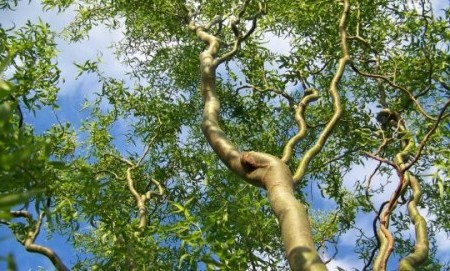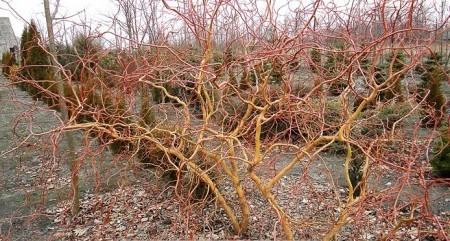Matsuda's willow is an interesting tree that reaches a height of 8-12 meters. If allowed to grow freely without pruning, it will form a broadly conical crown, with the tree's height being greater than its width.
Matsuda's willow not only has branches that grow in a whimsical manner, but also the long, narrow leaves are also curled, so the willow looks very delicate. The tree needs open sun and free space.
All willows have common properties:
- they grow quickly
- very hardy
- love moist soils
- easy to reproduce
- do not require special care.
Some gardeners complain that willow branches lean to one side. In order for the Matsudana willow to have a symmetrical crown, it should not grow close to the house or next to other tall trees, i.e. the space around it should be open. If your willow is still young, it can be transplanted to a suitable location.
Reproduction of tortuous willow. If replanting is not possible, take cuttings: Matsuda branches take root well. You can simply cut branches up to a meter long and stick them in a row into loose soil, remembering to water regularly. Within a year you will be able to transplant the trees to a suitable place. As you can see, propagating this plant is simply a pleasure.
Willow pruning. A few words about pruning. Matsudana, like other willows, are very flexible trees and lend themselves well to pruning, but... If you have begun to form a crown, then you will have to trim it every year, and over time, when the tree grows greatly in height, this will become increasingly difficult. If you start pruning and then stop doing it, you will disrupt the harmony of the crown.
I know from my own experience. Having planted such a willow at the dacha, she trimmed it every year. The crown became denser, the “openwork effect” was lost. Later, I planted a new willow tree in the center of the garden in an open space and did nothing with it: I let it grow freely. Without my care, the plant turned into a beautiful openwork tree with a symmetrical crown. The only thing I did was clear the lower part of the trunk from the branches to give the plant a clearer outline. Unlike the weeping willow, whose branches hang down, Matsuda's branches grow vertically, and thin side branches hang down.
You can deal with the twisted beauty in another way: “plant it on a stump” and grow it using the coppice method. As a result, you will get a large shrub. Some trees are grown this way, for example, white poplar, white willow, and some maples.
How it's done? If the trunk of your willow has a diameter of more than 5-6 cm, cut it down in the spring before the buds open, leaving a short stump. Powerful new shoots form on the stump (they grow up to one and a half meters or more during the season). It is these shoots that are used for propagation; they take root and grow better. Having decided to use this shaping method, “landing on a stump” will have to be done regularly.
Which growing method to use depends on your desire: to have a tall tree or a lush shrub in the garden.



 (2 ratings, average: 4,50 out of 5)
(2 ratings, average: 4,50 out of 5) CUCUMBERS NEVER GET SICK, I'VE BEEN USING ONLY THIS FOR 40 YEARS! I SHARE A SECRET WITH YOU, CUCUMBERS ARE LIKE THE PICTURE!
CUCUMBERS NEVER GET SICK, I'VE BEEN USING ONLY THIS FOR 40 YEARS! I SHARE A SECRET WITH YOU, CUCUMBERS ARE LIKE THE PICTURE! You can dig a bucket of potatoes from each bush. Do you think these are fairy tales? Watch the video
You can dig a bucket of potatoes from each bush. Do you think these are fairy tales? Watch the video
 How our fellow gardeners work in Korea. There is a lot to learn and just fun to watch.
How our fellow gardeners work in Korea. There is a lot to learn and just fun to watch. Eye trainer. The author claims that with daily viewing, vision is restored. They don't charge money for views.
Eye trainer. The author claims that with daily viewing, vision is restored. They don't charge money for views. A 3-ingredient cake recipe in 30 minutes is better than Napoleon. Simple and very tasty.
A 3-ingredient cake recipe in 30 minutes is better than Napoleon. Simple and very tasty. Therapeutic exercises for cervical osteochondrosis. A complete set of exercises.
Therapeutic exercises for cervical osteochondrosis. A complete set of exercises. Which indoor plants match your zodiac sign?
Which indoor plants match your zodiac sign? What about them? Excursion to German dachas.
What about them? Excursion to German dachas.
Dear Sergey! Please give me some advice. I bought a matsudana willow in the spring. A meter seedling. First I bought it, and then I learned about its properties. That is, it grows very tall and wide, this is impossible in my yard. I read in your article that if you cut it onto a stump in the spring, it will grow into a bush. Should I prune it every spring??? NOW my willow tree has two thin trunks, the height is a little more than 1.50. Cut it off every spring, or it will die. Please tell me what to do.
Good afternoon, Tamara.
A willow will not grow into a large tree in 1 year, so it will need to be cut down to a “stump” every 3-5 years. Or you can grow 2 shoots of different ages. Now you have 2 stems growing, in 1-3 years cut one and leave the other. Young shoots will begin to grow from the cut ones, leave one of them that is the best.After another 2-3 years, remove the old shoot, and by this time you will already have a 2-3 year old tree. And so on. The dates are of course very approximate. I have been growing tree trees this way for many years. True, the trees will grow at a slight slope, in different directions.